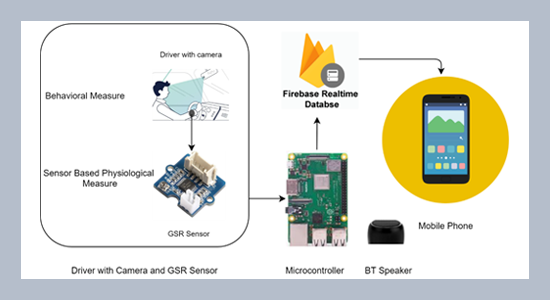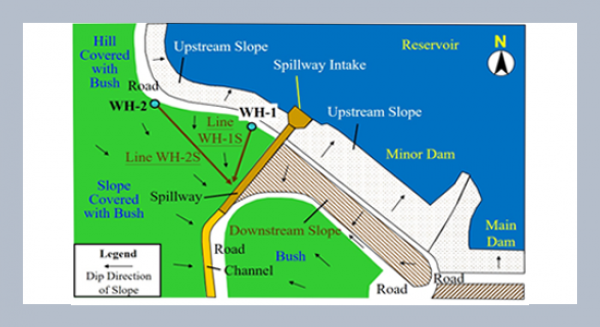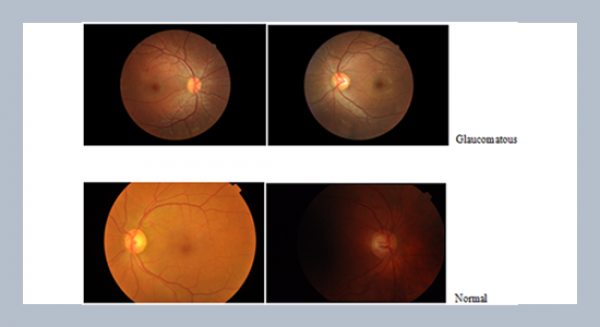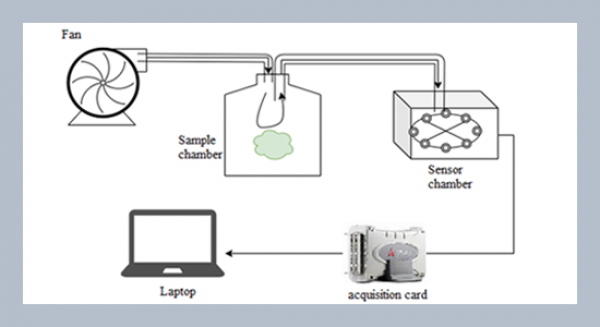REFERENCES
- Akiduki, T., Nagasawa, J., Zhang, Z., Omae, Y., Arakawa, T., Takahashi, H. 2022. Inattentive driving detection using body-worn sensors: Feasibility study. Sensors, 22, 352.
- Albadawi, Y., Takruri, M., Awad, M. 2022. A review of recent developments in driver drowsiness detection systems. Sensors, 2, 285–297.
- Bajaj, J.S., Kumar, N., Kaushal, R.K. 2021. Comparative study to detect driver drowsiness. 2021 International Conference on Advance Computing and Innovative Technologies in Engineering (ICACITE), 678–683.
- Bajaj, J.S., Kumar, N., Kaushal, R.K. 2022. Feasibility study on amalgamation of multiple measures to detect driver drowsiness. ECS Transactions, 107, 1951.
- Bajaj, J.S., Kumar, N., Kaushal, R.K. 2023. System and method to detect drowsiness of driver. (Patent No. 202311036778).
- Biswal, A.K., Singh, D., Pattanayak, B.K., Samanta, D., Yang, M.H. 2021. IoT-based smart alert system for drowsy driver detection. Wireless Communications and Mobile Computing, 2021, 1–13.
- Boyko, N., Basystiuk, O., Shakhovska, N. 2018. Performance evaluation and comparison of software for face recognition, based on dlib and opencv library. In 2018 IEEE Second International Conference on Data Stream Mining & Processing (DSMP), 478–482.
- Chen, J., Wang, S., He, E., Wang, H., Wang, L. 2021. Recognizing drowsiness in young men during real driving based on electroencephalography using an end-to-end deep learning approach. Biomedical Signal Processing and Control, 69, 102792.
- Cheng, B., Zhang, W., Lin, Y., Feng, R., Zhang, X. 2012. Driver drowsiness detection based on multisource information. Human Factors and Ergonomics in Manufacturing & Service Industries, 22, 450–467.
- Čolić, A., Marques, O., Furht, B., Čolić, A., Marques, O., Furht, B. 2014. Driver drowsiness detection and measurement methods. Driver Drowsiness Detection: Systems and Solutions, 7–18.
- Dhiman, P., Kukreja, V., Manoharan, P., Kaur, A., Kamruzzaman, M.M., Dhaou, I.B., Iwendi, C. 2022. A novel deep learning model for detection of severity level of the disease in citrus fruits. Electronics, 11, 495.
- Doudou, M., Bouabdallah, A., Berge-Cherfaoui, V. 2019. Driver drowsiness measurement technologies: Current research, market solutions, and challenges. International Journal of Intelligent Transportation Systems Research, 18, 297–319.
- Doudou, M., Bouabdallah, A., Cherfaoui, V., Charfaoui, V. 2018. A light on physiological sensors for efficient driver drowsiness detection system. Sensors & Transducers Journal, International Frequency Sensor Association (IFSA), 8, 224.
- Eye blink detection with OpenCV, Python, and dlib - PyImageSearch. 2017. Retrieved 2022-10-22 from https://pyimagesearch.com/2017/04/24/eye-blink-detection-opencv-python-dlib/
- Feng, R., Zhang, G., Cheng, B. 2009. An on-board system for detecting driver drowsiness based on multi-sensor data fusion using Dempster-Shafer theory. 2009 International Conference on Networking, Sensing and Control, 897–902.
- Grove - GSR Sensor - Seeed Wiki. Retrieved 2022-11-18 from https://wiki.seeedstudio.com/Grove-GSR_Sensor/
- Gwak, J., Hirao, A., Shino, M. 2020. An investigation of early detection of driver drowsiness using ensemble machine learning based on hybrid sensing. Applied Sciences, 10, 2890.
- Hasan, M.M., Watling, C.N., Larue, G.S. 2022. Physiological signal-based drowsiness detection using machine learning: Singular and hybrid signal approaches. Journal of Safety Research, 80, 215–225.
- Horne, J.A., Baulk, S.D. 2004. Awareness of sleepiness when driving. Psychophysiology, 41, 161–165.
- de Naurois, C.J., Bourdin, C., Stratulat, A., Diaz, E., Vercher, J.L. 2019. Detection and prediction of driver drowsiness using artificial neural network models. Accident Analysis & Prevention, 126, 95–104.
- Jadhav, A., Lone, S., Matey, S., Madamwar, T., Jakhete, S. 2021. Survey on face detection algorithms. International Journal of Innovative Science and Research Technology, 6, 291–297.
- Karim, S., He, H., Laghari, A.A., Magsi, A.H., Laghari, R.A. 2021. Quality of service (QoS): Measurements of image formats in social cloud computing. Multimedia Tools and Applications, 80, 4507–4532.
- Karim, S., Zhang, Y., Laghari, A.A., Asif, M.R. 2017. Image processing based proposed drone for detecting and controlling street crimes. 2017 IEEE 17th International Conference on Communication Technology (ICCT), 1725–1730.
- Kumari, B.M.K., Kumar, P.R. 2017. A survey on drowsy driver detection system. Proceedings of the 2017 International Conference on Big Data Analytics and Computational Intelligence (ICBDACI), 272–279.
- Kundinger, T., Alt, F., Kepler, J. 2021. Driver drowsiness detection systems: Potential of smart wearable devices to improve vehicle safety. [Doctoral Dissertation, Johannes Kepler University Linz].
- Lemkaddem, A., Delgado-Gonzalo, R., Türetken, E., Dasen, S., Moser, V., Gressum, C., Solà, J., Ferrario, D., Verjus, C. 2018. Multi-modal driver drowsiness detection: A feasibility study. Journal of Infectious Diseases, 145, 773.
- Leng, L.B., Giin, L.B., Chung, W.-Y. 2015. Wearable driver drowsiness detection system based on biomedical and motion sensors. In 2015 IEEE Sensors, 1–4.
- Lilhore, U.K., Imoize, A.L., Li, C.-T., Simaiya, S., Pani, S. K., Goyal, N., Kumar, A., Lee, C.-C. 2022. Design and implementation of an ML and IoT based Adaptive Traffic-management system for smart cities. Sensors, 22, 2908.
- Liu, W., Zhou, L., Chen, J. 2021. Face recognition based on lightweight convolutional neural networks. Information, 12, 191.
- Malathi, D., Dorathi Jayaseeli, J.D., Madhuri, S., Senthilkumar, K. 2018. Electrodermal activity based wearable device for drowsy drivers. Journal of Physics: Conference Series, 1000, 012048.
- McDonald, A.D., Lee, J.D., Schwarz, C., Brown, T.L. 2018. A contextual and temporal algorithm for driver drowsiness detection. Accident Analysis and Prevention, 113, 25–37.
- MCP3008 | Microchip Technology. Retrieved 2022-11-20 from https://www.microchip.com/en-us/product/MCP3008
- Murugan, S., Selvaraj, J., Sahayadhas, A. 2019. Analysis of different measures to detect driver states: A review. In 2019 IEEE International Conference on System, Computation, Automation and Networking, ICSCAN, 1–6.
- Naidu, B.A., Rao, D.K., Raju, D.M., Reddy, B.K.R., Harsha, B.N.S., Vamshi, A. 2020. Driver drowsiness alert system with computer vision using machine learning and engine stopping with raspberry Pi 4. International Journal of Innovations in Engineering and Technology, 15, 47–54.
- Ngxande, M., Burke, M. 2017. Driver drowsiness detection using Behavioral measures and machine learning techniques : A review of state-of-art techniques. 2017 Pattern Recognition Association of South Africa and Robotics and Mechatronics (PRASA-RobMech), 156–161.
- Shahrudin, N.N., Sidek, K.A. 2020. Driver drowsiness detection using different classification algorithms. Journal of Physics: Conference Series, 1502, 012037.
- Ramzan, M., Khan, H.U., Awan, S.M., Ismail, A., Ilyas, M., Mahmood, A. 2019. A survey on state-of-the-art drowsiness detection techniques. IEEE Access, 7, 61904–61919.
- Sahayadhas, A., Sundaraj, K., Murugappan, M. 2012. Detecting driver drowsiness based on sensors: A review. Sensors, 12, 16937–16953.
- Savaş, B.K., Becerikli, Y. 2020. Real time driver fatigue detection system based on multi-task ConNN. IEEE Access, 8, 12491–12498.
- Shahid, A., Wilkinson, K., Marcu, S., Shapiro, C.M. (Eds.). 2012. STOP, THAT and one hundred other sleep scales. Springer Science & Business Media, 209–210.
- Sharma, M., Kacker, S., Sharma, M. 2016. A brief introduction and review on galvanic skin response. International Journal of Medical Research Professionals, 2, 13–17.
- Shi, W., Li, J., Yang, Y. 2020. Face Fatigue detection method based on mtcnn and machine vision. Advances in Intelligent Systems and Computing, 1017, 233–240.
- Shrivastava, A., Haripriya, D., Borole, Y.D., Nanoty, A., Singh, C., Chauhan, D. 2022. High performance FPGA based secured hardware model for IoT devices. International Journal of System Assurance Engineering and Management, 13, 736–741.
- Singh, N., Brisilla, R. M. 2021. Comparison analysis of different face detecting techniques. 3rd IEEE International Virtual Conference on Innovations in Power and Advanced Computing Technologies, i-PACT, 1–6.
- Soares, S., Monteiro, T., Lobo, A., Couto, A., Cunha, L., Ferreira, S. 2020. Analyzing driver drowsiness: From causes to effects. Sustainability, 12, 1–12.
- Uday, G., Bhargava, K., Reddy, G.K., Rambabu, K. 2021. Supervised learning algorithm driver drowsiness detection and alerting system. Journal of Engineering Sciences, 12, 502–507.
- Verma, K., Bhardwaj, S., Arya, R., Islam, U.L., Bhushan, M., Kumar, A., Samant, P. 2019. Latest tools for data mining and machine learning. International Journal of Innovative Technology and Exploring Engineering, 8, 18–23.
- Viola, P., Jones, M. 2001. Rapid object detection using a boosted cascade of simple features. Proceedings of the 2001 IEEE Computer Society Conference on Computer Vision and Pattern Recognition. CVPR 2001, 1, I–I.
- Wang, L., Shoulin, Y., Alyami, H., Laghari, A.A., Rashid, M., Almotiri, J., Alyamani, H.J., Alturise, F. 2022. A novel deep learning-based single shot multibox detector model for object detection in optical remote sensing images. Wiley Online Library, 2022, 1–15.
- Weng, C.H., Lai, Y.H., Lai, S.H. 2017. Driver drowsiness detection via a hierarchical temporal deep belief network. In Computer Vision–ACCV 2016 Workshops: ACCV 2016 International Workshops, Taipei, Taiwan, Revised Selected Papers, Part III 13, 117–133.
- Yongcun, W., Jianqiu, D. 2021. Online examination behavior detection system for preschool education professional skills competition based on MTCNN. 2021 IEEE 2nd International Conference on Big Data, Artificial Intelligence and Internet of Things Engineering (ICBAIE), 999–1005.
- Zhang, N., Luo, J., Gao, W. 2020. Research on face detection technology based on MTCNN. Proceedings - 2020 International Conference on Computer Network, Electronic and Automation (ICCNEA), 154–158.















